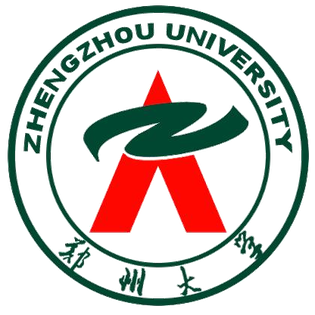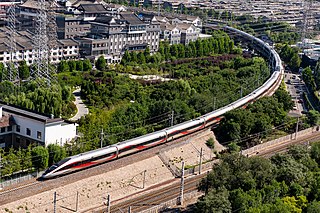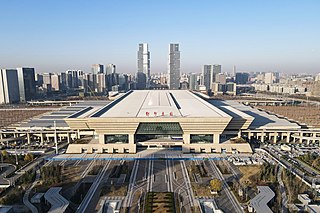Related Research Articles

Anhui is an inland province located in East China. Its provincial capital and largest city is Hefei. The province is located across the basins of the Yangtze and Huai rivers, bordering Jiangsu and Zhejiang to the east, Jiangxi to the south, Hubei and Henan to the west, and Shandong to the north. With a population of 61 million, Anhui is the 9th most populous province in China. It is the 22nd largest Chinese province based on area, and the 12th most densely-populated region of all 34 Chinese provincial regions. Anhui's population is mostly composed of Han Chinese. Languages spoken within the province include Lower Yangtze Mandarin, Wu, Hui, Gan and small portion of Central Plains Mandarin.

The Shanghai Cooperation Organisation (SCO) is a Eurasian political, economic, international security and defence organization established by China and Russia in 2001. It is the world's largest regional organization in terms of geographic scope and population, covering approximately 80% of the area of Eurasia and 40% of the world population. As of 2021, its combined GDP was around 20% of global GDP.

He'nan is an inland province of China. He'nan Province is home to many heritage sites, including the ruins of Shang dynasty capital city Yin and the Shaolin Temple. Four of the Eight Great Ancient Capitals of China, Luoyang, Anyang, Kaifeng and Zhengzhou, are in He'nan. The practice of tai chi also began here in Chen Jia Gou Village, as did the later Yang and Wu styles.

Kaifeng is a prefecture-level city in east-central Henan province, China. It is one of the Eight Ancient Capitals of China, having been the capital eight times in history, and is most known for having been the Chinese capital during the Northern Song dynasty.

Suzhou is a city in southern Jiangsu of eastern China.

Zhengzhou University is a provincial public university in Zhengzhou, Henan, China. It is affiliated with the Province of Henan. The university is part of Project 211 and the Double First-Class Construction.

Xinzheng is a county-level city of Henan Province, China. It is under the administration of the prefecture-level city of Zhengzhou, the provincial capital. The city has a population of 600,000 people and covers an area of 873 square kilometres (337 sq mi), 15 km2 (5.8 sq mi) of which is urban.

Kunshan is a county-level city in southeastern Jiangsu province with Shanghai bordering its eastern border and Suzhou on its western boundary. It is under the administration of the prefecture-level city of Suzhou.

The high-speed rail (HSR) network in the People's Republic of China (PRC) is the world's longest and most extensively used – with a total length of 45,000 kilometres (28,000 mi) by the end of 2023. The HSR network encompasses newly built rail lines with a design speed of 200–380 km/h (120–240 mph). China's HSR accounts for two-thirds of the world's total high-speed railway networks. Almost all HSR trains, track and service are owned and operated by the China Railway Corporation under the brand China Railway High-speed (CRH).
Xu Guangchun was a Chinese politician who served as the Communist Party Secretary of Henan province between 2004 and 2009.

The Shijiazhuang–Wuhan high-speed railway, or Shiwu passenger railway, is an 840 km (520 mi) high-speed rail line operated by China Railway High-speed between Shijiazhuang and Wuhan, the provincial capitals of Hebei and Hubei, respectively. Construction commenced in October 2008, with a total investment of 116.76 billion yuan. The design speed is 350 km/h (220 mph). It is part of the Jingguang passenger-dedicated line, a high-speed railway connecting Beijing and Guangzhou, which runs parallel to the older conventional Jingguang Railway.

The Zhengzhoudong railway station is a railway station for high-speed trains in Zhengzhou, Henan, China. It is located approximately 3 km southeast of the Zhengdong New Area CBD. On the junction of the North-South Beijing–Guangzhou–Shenzhen–Hong Kong high-speed railway and the East-West Xuzhou–Lanzhou high-speed railway, it is one of the largest passenger railway stations in China.

Qufu East railway station is a high-speed railway station in Qufu, Jining, Shandong, China. It is served by the Beijing–Shanghai high-speed railway.

The Beijing–Guangzhou–Shenzhen–Hong Kong high-speed railway or Jingguangshengang high-speed railway from its Chinese name is a high-speed railway corridor of the CRH passenger service, connecting Beijingxi station in Beijing and Futian station in Shenzhen, Guangdong in less than nine hours of travel time. It is 2,230 kilometres (1,390 mi) long, and is the only Chinese high-speed railway to cross a border that requires immigration and customs clearance. The existing, conventional Jingguang railway runs largely parallel to the line.
In China, a national central city (国家中心城市) is a modern metropolis with regional, national, and international importance. There are nine national central cities: Beijing, Tianjin, Chongqing, Shanghai, Guangzhou, Chengdu, Wuhan, Xi'an, and Zhengzhou.The first four cities listed are the four provincial-equivalent direct-administered municipalities of China.

The CRH380A Hexie is a Chinese electric high-speed train that was developed by CSR Corporation Limited (CSR) and is currently manufactured by CRRC Qingdao Sifang. As a continuation of the CRH2-380 program it both replaces foreign (Japanese) technology in the CRH2 with Chinese developments and increases its top speed. The CRH380A is designed to operate at a cruise speed of 350 km/h (217 mph) and a maximum speed of 380 km/h (236 mph) in commercial service. The original 8-car train-set recorded a top speed of 416.6 km/h (258.9 mph) during a trial run. The longer 16-car train-set reached 486.1 km/h (302.0 mph).
China operates a number of supercomputer centers which, altogether, hold 29.3% performance share of the world's fastest 500 supercomputers. China's Sunway TaihuLight ranks third in the TOP500 list.

Ding Xuexiang is a Chinese politician who is currently the first vice premier of the People's Republic of China and the sixth-ranked member of the Politburo Standing Committee of the Chinese Communist Party. He has also been leader of the Central Leading Group on Hong Kong and Macau Affairs since March 2023.

China Adolescents Science & Technology Innovation Contest is one of the biggest national science competitions in China held by organizations including China Association for Science and Technology and Ministry of Education of the People's Republic of China. Every year, more than 10 million students from all parts of China submit their projects in local-level competitions and up to 500 projects are eventually selected for the CASTIC. A few top projects are further selected to participate in competitions including Broadcom Masters International, Intel International Science and Engineering Fair, or European Union Contest for Young Scientists.

Lei Jieqiong, also known as Kit King Lei, was a Chinese sociologist, activist, and politician. Educated in the United States, she taught at Yenching University, China University of Political Science and Law, and Peking University in Beijing and Soochow University, St. John's University, University of Shanghai, and Aurora University in Shanghai. She was a cofounder of Zhongzheng University in Jiangxi during the Second Sino-Japanese War.
References
- 1 2 "2013年全国地方高水平大学发展峰会在我校召开". zsb.suda.edu.cn. 2013-12-07. Retrieved 2024-01-19.